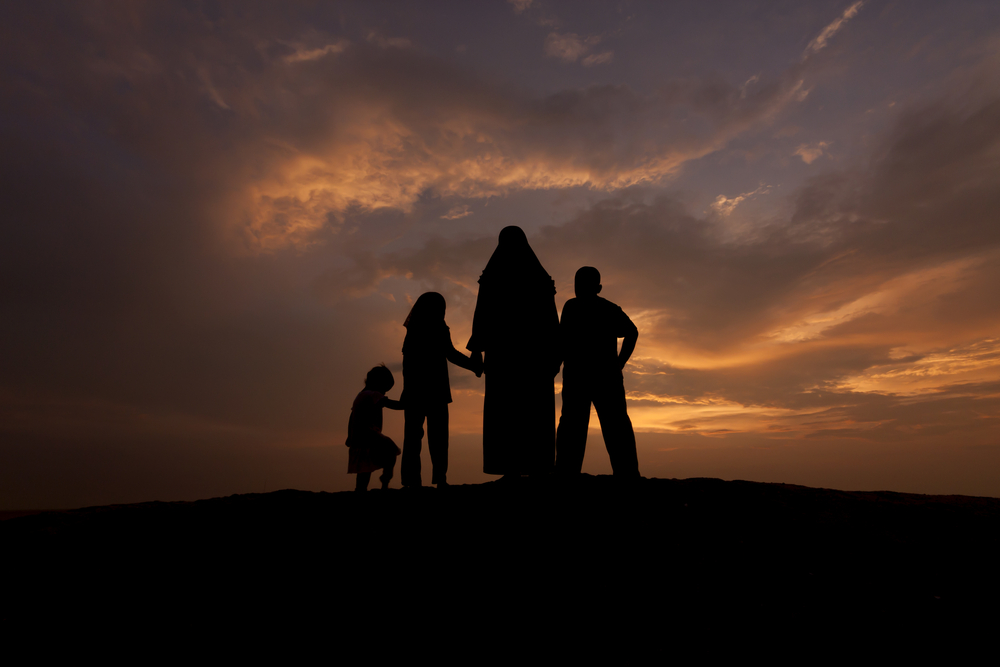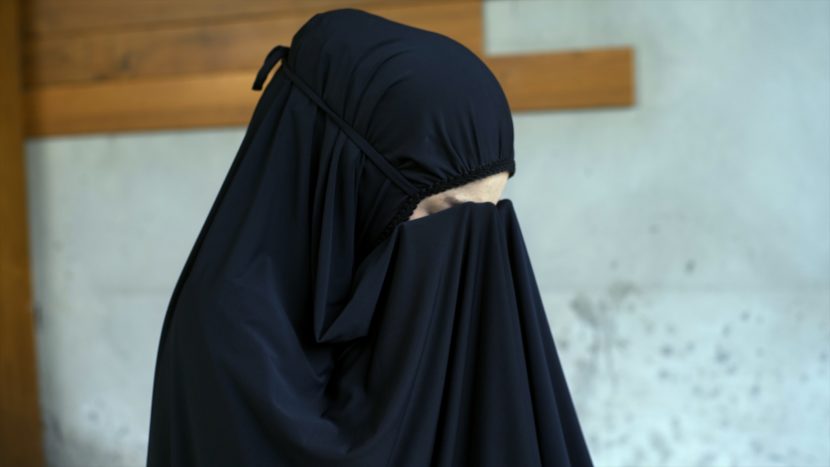Between 2013 and 2019, an estimated 664 to 746 Western women travelled to Syria and Iraq to join the Islamic State (ISIS). Women and girls supported ISIS not only by marrying fighters, but also by engaging in propaganda, recruitment, and in some cases, armed roles. After the fall of the Caliphate in 2019, many of these women and their children were detained in the Al-Hol and Roj camps, where serious and ongoing violations of children’s rights continue.
The roles of women and girls within ISIS
Since the rise of the Caliphate, some women were recruited by ISIS’s Al-Khansaa Brigade, enforcing morality rules and engaging in propaganda, recruitment, and online grooming of other women and girls. Girls recruited into ISIS were often referred to as “sisters of the Islamic State” and trained to support husbands, sometimes from as young as age nine (Capone, 2019).
Women’s involvement went beyond the role of “jihadi brides” (women and girls who were recruited to marry jihadist fighters) or muhajirat (female migrants to ISIS territory). Between 2015 and 2018, as ISIS weakened militarily, it publicly declared that it had become “obligatory for women to take up arms.”
During this period, some women reportedly received sniper training, carried weapons, and even wore suicide vests. However, the extent of women’s participation in violence remains under-documented, partly because ISIS propaganda prioritized showcasing male fighters (Kumar, 2021).
How many women and girls left Western countries to join the ISIS cause?
More recent reports estimate that in Western European countries – specifically Belgium, France, Germany, Ireland, and the Netherlands – between 664 and 746 women travelled to conflict zones in Iraq and Syria since the establishment of the Caliphate in 2013.
In the United Kingdom (UK) and Sweden, 150 and 75 women, respectively, were documented to have travelled to conflict zones. In the United States (US), there were 38 women, and in Australia, 30 to 40 female Australians fled to become ISIS supporters (people who assist terrorist groups) (Kumar, 2021). According to Swedish official figures, about 300 Swedes have been recruited by jihadi groups in the Middle East, making Sweden second only to Belgium as the largest contributor of Islamist militants from Europe (Crouch, 2016).
Online targeting of girls for recruitment as “ISIS brides”
Many of these women were teenagers, whom the terrorist organization targeted to become child brides for its fighters. The well-trained recruiters appealed to these young women’s sense of “honour” and played upon their naiveté, describing a life of domestic bliss amongst like-minded people in idyllic scenes from territory controlled by ISIS. These campaigns were often conducted through social media, and tended to downplay the state of violence their recruits would be living in (Al Khazraji, 2023).

Once recruited, they also became the recruiters. 80 percent of these women spent most of their day on social media trying to attract new members to the jihadist cause. Their fluency in Western languages gave them a competitive advantage in this task (Al Khazraji, 2023).
The reality of the situation for these women was quite different than what they were promised. They not only had to carry out their duties as “ISIS brides” — cooking, cleaning, giving birth to and raising children — but worked as patrol officers, fighters and prison guards after the terrorist group’s imams issued a “fatwa” allowing it, given that the Caliphate was under threat and there were not enough men to protect it (Al Khazraji, 2023).
Combat roles were permitted only in rare, exceptional circumstances, such as self-defence or with explicit approval from an emir. This vision contrasts with some militant self-narratives from muhajirat but reflects the Islamic State’s ideological commitment to a restrictive, gendered division of jihad (Winter & Margolin, 2017).
What led women and girls to join ISIS?
People join organisations such as ISIS for religious, psychological, and economic reasons, but the most significant factor affecting Muslim women who join jihadist organisations is religious indoctrination. Many first- and second-generation migrants tend to want to preserve their sense of Islamic identity and pass it on to their children (Al Khazraji, 2023).
Most parents of ISIS recruits did not encourage their children to join such organisations, and were not aware of their children’s radicalisation, but their strict, often conservative religious ideology likely contributed to their children’s decisions. Some studies suggest that young girls, for example, turn to ISIS as a coping strategy for overcoming an adolescent identity crisis (Al Khazraji, 2023).
Muslims born into immigrant families also usually feel conflicted about their identity because of cultural and religious differences with Western culture, which leaves them more vulnerable to extremist groups. Some of these women face racism and anti-Islamic sentiment in the West, including negative attitudes about the wearing of the hijab or niqab. Some women were made to feel guilty about their privileged life in the West, and this triggered a desire to give back. Joining ISIS gave them a sense of belonging to a global cause (Al Khazraji, 2023).
Two stories of Western girls who were recruited by ISIS
Between 2012 and 2019, a significant number of foreigners travelled to Syria and Iraq, many to join ISIS and live under what came to be the so-called “Caliphate”. Their backgrounds and journeys are as diverse as their nationalities (Eriksson, 2024).
- Shamima Begum from the UK: in 2015, Shamima was 15 years old when she left London with two school friends to join ISIS in Raqqa, Syria, after being recruited online. There, she married an ISIS fighter and had two children who later died in infancy. In 2019, she sought to return to the UK, but the government revoked her citizenship, citing national security concerns. Shamima’s legal appeals failed, and in 2021, the UK Supreme Court ruled she could not return to pursue her case. In the meantime, she remained in the al-Roj camp in northeast Syria (Al Khazraji, 2023).
- Shayma Assaad from Australia: in 2015, Shayma was just 15 when her parents took her from Sydney to Syria. She has given birth to four children in Syrian detention camps, who will also be repatriated. The youngest child is aged three. Her husband, a Sydney tradesman turned Islamic State fighter, Mohammed Noor Masri, has been detained by Kurdish authorities since 2019. Shayma’s mother Bessima Assaad is also expected to be repatriated, alongside her two other daughters Assya and Maysa. Her mother’s husband, Ahmad, a former Crown Security employee, is jailed in Syria (Knott, 2022).
The urgent need to protect ISIS-associated children
Children linked to ISIS are often labelled a “ticking time bomb” — a phrase used by the EU Counter-Terrorism Coordinator to highlight the risks of failing to provide them with disengagement and rehabilitation support.
Children are recruited by armed groups in three main ways: through coercion, voluntary enlistment, or being born into them (Capone, 2019). In ISIS-controlled areas, entire families were involved; many foreign terrorist fighters (FTFs) (individuals who travel abroad to join terrorist groups) brought children or started families in Syria and Iraq.
ISIS encouraged fighters to train their children as “lion cubs” (ashbal), exposing some to indoctrination from age six and military training by nine. These practices have led many states to focus on security concerns over reintegration (Capone, 2019).
Following ISIS’s territorial defeat in March 2019, thousands, mostly women and children, were detained in northeast Syria. The Al-Hol and Roj camps hold around 42500 people, including 18000 foreign nationals. Most are relatives of suspected ISIS members.
Conditions in these camps are dire: detainees have been held for over six years without charge, in what human rights groups call inhuman and unlawful detention (HRW, 2025). About two-thirds of those detained are children, many born in the camps or brought as infants, too young to have participated in ISIS activities.
The UN has condemned this collective punishment, noting it violates the Convention on the Rights of the Child.
“These children are victims of terrorism and of very serious violations of international human rights and humanitarian law… Safe return to their home countries… must be prioritized.”
— UN-appointed experts, including Fionnuala Ní Aoláin (UN News, 2023)
What are states’ legal obligations to women and children detained after ISIS?
With large numbers of women remaining in Al-Hol and Al-Roj detention camps, governments have to reconcile their obligations to guarantee the rights of their citizens seeking to return while also considering the possible threat these returnees pose to domestic security.
International law does not universally obligate States to repatriate citizens, though it is strongly encouraged under the UN frameworks. The justice systems of Australia, the UK, the US, and several European countries have faced ongoing criticism due to their prosecution of returning foreign terrorist fighters (FTFs) and individuals associated with terrorism (Kumar, 2021).
Women associated with ISIS often have children, which complicates the judicial process as there is an impetus to repatriate children. Given that some countries, such as Germany, require children to be repatriated with their mothers, there are additional challenges in repatriating and potentially charging women associated with ISIS as they no longer are viewed just as “jihadi brides,” but possible perpetrators and facilitators of violence (Kumar, 2021). While some countries, including the US, have facilitated limited returns, repatriation efforts remain inconsistent and politically fraught.
The challenge of repatriation: Women, children, and the way forward
Since ISIS’s territorial defeat, thousands of foreign nationals — including women and children — have been detained in camps across Syria. While some 36 countries have accepted returnees, progress has been slow. Iraq has repatriated over 10,000 of its citizens, but many European states remain hesitant. Some have even revoked citizenship, leaving individuals stateless (HRW, 2025).
As of 2021, over 200 women had returned to Europe, yet only a small number have faced trial. This highlights a wider issue: legal systems remain inconsistent in how they prosecute women affiliated with ISIS, often failing to account for the diversity of roles they may have played — from victims to enablers (Kumar, 2021).
Children make up the majority of detainees. Though many governments claim to view them as victims, particularly those under age 10, few have taken concrete steps to bring them home. Child rights experts warn of “double victimisation”: children who were indoctrinated or born into conflict now face prolonged detention, stigma, and statelessness (Capone, 2019).
Repatriation is widely seen as the only sustainable solution, both to uphold human rights and reduce long-term security risks. Detaining people indefinitely without due process violates international law. UN Security Council resolutions stress the importance of reintegration for women and children affiliated with terrorist groups (HRW, 2025).

At Humanium, we strongly condemn the ongoing violations of children’s rights in these camps. We call on states to recognise these children as victims, not threats, and to act now to protect their rights and futures. If you want to contribute to our cause, consider making a donation, volunteering or becoming a member.
Written by Arianna Braga
References:
Al Khazraji, R. (2023). Turning to terrorism: Why Shamima Begum and other women joined ISIS. Retrieved from TRENDS Research & Advisory at https://trendsresearch.org/insight/turning-to-terrorism-why-shamima-begum-and-other-women-joined-ISIS/, accessed on 16 May 2025.
Crouch, D. (2016). Spotlight on Nordic recruiting ground for ISIS fighters’ child brides. Retrived from The Guardian at https://www.theguardian.com/world/2016/feb/25/marilyn-nevalainen-case-highlights-swedish-move-to-end-extremism, accessed on 26 May 2025.
Hassan, M. (2023). Why ISIS Cannot Bring the Caliphate Back to Life. Retrieved from Carnegie Endowment for International Peace at https://carnegieendowment.org/sada/2023/07/why-ISIS-cannot-bring-the-caliphate-back-to-life?lang=en, accessed on 27 May 2025.
HRW (2025). Northeast Syria: Camp Detainees Face Uncertain Future. Retrieved from Human Rights Watch (HRW) at https://www.hrw.org/news/2025/02/07/northeast-syria-camp-detainees-face-uncertain-future, accessed on 26 May 2025.
Knott, M. (2022). Government begins repatriating relatives of Islamic State fighters from Syria. Retrieved from The Sydney Morning Herald at https://www.smh.com.au/politics/federal/government-begins-repatriating-relatives-of-islamic-state-fighters-from-syria-20221028-p5btq1.html, accessed on 26 May 2025.
Kumar, R. (2021). Female Foreign Terrorist Fighters: Challenges in Repatriation, Prosecution, and Rehabilitation. Retrieved from Counter Terrorism Project at https://www.counterextremism.com/content/female-foreign-terrorist-fighters-challenges-repatriation-prosecution-and-rehabilitation, accessed on 26 May 2025.
Margolin, D., Jablonski, C. (2024). Five Years After the Caliphate, Too Much Remains the Same in Northeast Syria. Retrieved from The Washington Institute for Near East Policy at https://www.washingtoninstitute.org/policy-analysis/five-years-after-caliphate-too-much-remains-same-northeast-syria, accessed on 27 May 2025.
UN News (2023). ‘Bring them home’: UN experts call for repatriating detained Syria children. Retrieved from UN News at https://news.un.org/en/story/2023/03/1135207, accessed on 26 May 2025.
Winter, C., Margolin, D. (2017). The Mujahidat Dilemma: Female Combatants and the Islamic State. Retrieved from Combating Terrorism Center at https://ctc.westpoint.edu/the-mujahidat-dilemma-female-combatants-and-the-islamic-state, accessed on 6 June 2025.


